| |
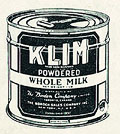 |
|
| |
 Powdered
milk was a boon to cottagers who had no electricity. Eaton's Camp and
Cottage Book, 1939, p. 21. Powdered
milk was a boon to cottagers who had no electricity. Eaton's Camp and
Cottage Book, 1939, p. 21.
|
|
| |
|
|
|
Eaton's wasn't alone, of course. Simpson's delivered,
as
did local merchants. Joyce Graham remembers when both the ice man and the
vegetable
boat made regular stops at her parents' Georgian Bay island, near
Pointe
au Baril, Ont. But the big summer order, delivered just after opening,
came from
the icon of mail order. "I can still picture Mother making her
list,"
Graham recalls, "and it always included powdered milk,
'Klim'
they called it … disgusting stuff!"
| |
 |
|
| |
 Eaton's
delivered the goods to cottagers across the country. Eaton's Camp and
Cottage Book, 1940, p. 43. Eaton's
delivered the goods to cottagers across the country. Eaton's Camp and
Cottage Book, 1940, p. 43.
|
|
| |
|
|
|
Today, those special cottage catalogues are almost as hard to find as
cottagers
who were old enough to rebel against Klim so long ago. The earliest
edition of
Eaton's Summer Home Handbook was smaller than the regular catalogue,
and
much, much slimmer at just 32 pages. They weren't mailed widely,
like the
regular catalogues, but had to be picked up at the store or requested by
mail.
The Handbook reappeared annually until 1937 and then returned in 1939 with
a
few more pages and a new name: Eaton's Camp and Cottage Book.
| |
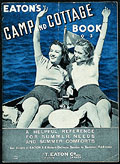 |
|
| |
 Eaton's
Camp and Cottage Book, 1939, cover. Eaton's
Camp and Cottage Book, 1939, cover.
|
|
| |
|
|
|
The cottage books didn't mark any grand departure for
Eaton's,
which began its catalogue business in 1884 (Simpson's followed 10
years
later). The company had always sold what we think of as cottage goods
—
things like oil lamps and fishing tackle. But the idea of a unique cottage
market
wasn't quite so obvious when ordinary rural residents still used oil
lamps
and summer homes were for the wealthy few.
| |
 |
|
| |
 The
catalogue sold a variety of fishing lures to enthusiastic anglers. Eaton's
Camp and Cottage Book, 1940, p. 28. The
catalogue sold a variety of fishing lures to enthusiastic anglers. Eaton's
Camp and Cottage Book, 1940, p. 28.
|
|
| |
|
|
|
The "Summer Needs" insert of 1897, for example, ran 13
pages of
bicycles before it got around to other "summer requisites"
like the
"Labrador" icebox ($8.25) and the Arrowwanna woven hammock,
with
valance and pillow ($1.50). Eaton's didn't remark on whether
these
were intended for the lake or the backyard.
| |
 |
|
| |
 Large
goods, such as motors and boats, could be bought through the catalogue.
Eaton's Summer Home Handbook, 1937, p. 28 Large
goods, such as motors and boats, could be bought through the catalogue.
Eaton's Summer Home Handbook, 1937, p. 28
|
|
| |
|
|
|
When the idea of cottage was still in its infancy, Eaton's lumped
outdoor
enthusiasts together in some unusual combinations. The spring-and-summer
catalogue
of 1901 divides camping supplies between page 197, where tents share the
page
with flags and awnings, and the back cover, where camp beds and hammocks
appear
with lawn mowers and horse nets. The very Methodist Mr Eaton, who
wouldn't
countenance alcohol, tobacco or playing cards in his catalogues or his
stores,
had a full page of "Guns, Rifles (and) Ammunition" facing a
page
of "Bibles, Hymn and Prayer Books" in the same catalogue.
"Sportsmen's Supplies," a special flyer from about
1905,
includes a scene from "Lake Rosseau" [sic] in
Muskoka, plus
illustrations of a camper, a hunter, and a fisherman, all well equipped
and therefore
successful in their outdoor pursuits. "The object of this booklet is
to
direct your attention to some of Ontario's beauty spots," the
back
page claims. "The landscapes you must see to appreciate, and, if you
would
have game in abundance and fish in plenty, you must visit our forests,
lakes
and streams. To do so in comfort, it is necessary to be properly equipped.
We
have studied your needs, so that we are enabled to provide you with
everything
you require; and that, too, with the minimum of trouble."
| |
 |
|
| |
 The
catalogue also provided cottagers with helpful guides to hunting and
fishing. Eaton's Summer Home Handbook, 1937, p. 24-25. The
catalogue also provided cottagers with helpful guides to hunting and
fishing. Eaton's Summer Home Handbook, 1937, p. 24-25.
|
|
| |
|
|
|
So little trouble that the booklet ends with a helpful summary of
Ontario's
fish and game laws.
| |
 |
|
| |
 All
of a cottager's fishing needs could be met through the Eaton's catalogue.
Eaton's Camp and Cottage Book, 1940, p. 28. All
of a cottager's fishing needs could be met through the Eaton's catalogue.
Eaton's Camp and Cottage Book, 1940, p. 28.
|
|
| |
|
|
|
It wasn't until 1934 that Eaton's identified cottaging as a
market
that might merit its own catalogue. Camping and fishing gear remained with
sporting
goods in the big catalogues, which continued to be the encyclopedia of
everything
Canadians might want to buy (except spirits and tobacco; playing cards had
made
it in). The first Summer Home Handbook did, however, bring cottage
essentials
together. It must have been a success because the next edition in 1935
announced
"Back Again!" and (shades of 1905) included Ontario's
fish
and game laws plus a fishing guide.
| |
 |
|
| |
 Eaton's
delivered orders to the nearest station or dock, or even right to the
cottage door. Eaton's Summer Home Handbook, 1937, p. 18-19. Eaton's
delivered orders to the nearest station or dock, or even right to the
cottage door. Eaton's Summer Home Handbook, 1937, p. 18-19.
|
|
| |
|
|
|
Most significantly, the 1935 Handbook introduced a new twist to
Eaton's
already generous delivery policy. Like modern courier services, mail and
freight
didn't deliver to cottages as readily as they did to year-round
residences.
So, for cottagers, Eaton's promised delivery to the nearest
steamship dock
or railway station and, where possible, "direct to your summer
home."
If the steamship wouldn't stop at the cottage dock, the local water
taxi
or freight boat would, and at Eaton's expense.
| |
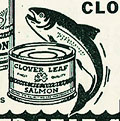 |
|
| |
 Canned
goods could be stored all summer at the cottage. Eaton's Camp and Cottage
Book, 1939, p. 10. Canned
goods could be stored all summer at the cottage. Eaton's Camp and Cottage
Book, 1939, p. 10.
|
|
| |
|
|
|
The 1936 catalogue put the policy this way: "We have built up a
very
speedy, close-to-the-camp-or-cottage-as-possible delivery which
you'll
find it hard to beat ... and EVERY grocery order is packed in
convenient-sized
boxes strapped for shipping." When perishables were added, like
fresh meat,
the cottager had to pay the difference between the standard freight rate
and
express, plus a few pennies for the dry ice in which to pack it.
| |
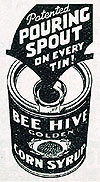 |
|
| |
 Many
grocery items were available through the Eaton's catalogue. Eaton's Camp
and Cottage Book, 1939, p. 9. Many
grocery items were available through the Eaton's catalogue. Eaton's Camp
and Cottage Book, 1939, p. 9.
|
|
| |
|
|
|
Otherwise, Eaton's paid the freight on food orders of more than
$15
within a radius of 200 miles [322 km] of Toronto. General merchandise was
delivered
free within the same area, so long as the order was more than $2, or $5
for bulky
items like furniture and china. And there was at least one exception by
weight.
A 1939 summer sale advertised the Brock wood-burning cookstove for $59.85
delivered.
But, since the lightest model weighed 470 lbs, Eaton's added this
proviso:
"Waterfront $5.00 extra."
Given the prices of the day, it's hardly surprising that the
company
wanted to avoid paying freight on orders of less than $2. Especially with
the
promise that anything could be returned at Eaton's expense. A box of
50
fresh dew worms cost 65¢. If the fish didn't bite, the worms
might
be blamed and sent back to Toronto. Likewise, the summer reading. When you
could
borrow a book from Eaton's Lending Library for 3¢ a day, you
could
hardly expect them to deliver a novel to your dock and then pay to return
it
with a full refund if you didn't like the ending. Some customers
were almost
that demanding. Like the woman who sent back the bedpan she'd had
for 13
years because it was now the wrong shape for her bottom. Eaton's
sent a
full refund.
| |
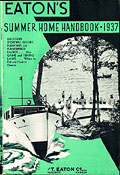 |
|
| |
 Eaton's
Summer Home Handbook, 1937, cover. Eaton's
Summer Home Handbook, 1937, cover.
|
|
| |
|
|
|
Cottagers weren't the only group of customers to attract
Eaton's
attention. The Winnipeg store had a special "Farmers' Waiting
Room,"
with comfy chairs where country patrons could gossip or read while their
wives
finished shopping. In Ontario, the company published a catalogue for
prospectors,
carrying much the same goods advertised in the 1937 Summer Home Handbook.
Only
the names and the prices changed. Cottagers, for example, were offered a
16'
Peterborough canoe called "The Competition" for $63.50, while
the
working woodsmen could buy a virtually identical craft, renamed "The
Huron,"
for $82. Like the cottagers, prospectors could expect Eaton's to
deliver
the canoe for free. And, as with the cottage fishing guide, Eaton's
invited
bushwhackers to write for their special prospectors' guide. Whether
how-to
advice from a Toronto merchant ever led a prospector to the motherlode is
less
certain than the laughs such an offer would have roused in hard-rock
country.
Prospectors didn't enjoy a lot of shopping options. But
cottagers, accustomed
to Eaton's service in the city, took their consumer habits north,
often
in direct competition with local suppliers. Noreen Bryson's parents
cottaged
on Lost Channel, between Severn Falls and Big Chute. "We had all the
staples
delivered at the beginning of the season," she recalls.
"Mother went
down to Eaton's [in Toronto] and made out the order at their desk,
giving
the date we'd arrive at the cottage. The local station had a special
storage
place where all this stuff would be taken off the train and held for
pickup or
delivery." Bryson was just a girl at the time, but she suggests that
Doug
Smith, a local jack of all trades, might have made the last leg of the
Eaton's
delivery, 7 km down the Severn River to the cottage.
| |
 |
|
| |
 Kraft
Dinner was a favourite Canadian food even in the 1930s. Eaton's Camp
and Cottage Book, 1939, p. 13. Kraft
Dinner was a favourite Canadian food even in the 1930s. Eaton's Camp
and Cottage Book, 1939, p. 13.
|
|
| |
|
|
|
Doug Smith's daughter, Helen Diak, suggests it's possible.
Smith,
indeed, had a delivery boat, but he usually carried his own merchandise
aboard,
not Eaton's. "We lived in the community hall, which belonged
to the
cottage owners' association, and they had an agreement not to sell
anything
but cigarettes or candy. So Dad couldn't have a store in the house.
But
he did have a barge with a sort of building on it, stacked with groceries
and
stuff packed in ice — milk, eggs, cheese. He'd deliver,
cottage to
cottage. There was no way of calling him [for an order], but he'd do
a
regular round, maybe twice a week."
| |
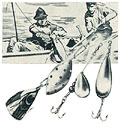 |
|
| |
 A
wide range of lures was available in the catalogue. Eaton's Camp and
Cottage Book, 1940, p. 28. A
wide range of lures was available in the catalogue. Eaton's Camp and
Cottage Book, 1940, p. 28.
|
|
| |
|
|
|
Eaton's accepted orders by phone, by mail or at the store. The
choice
had something to do with convenience, and a lot to do with the
difficulties of
arranging payment in pre-credit days. It wasn't until 1936 that
Eaton's
began allowing limited charge accounts. Prior to that, buying was by
Timothy
Eaton's "strictly cash" policy, or through deposit
accounts,
whereby customers paid in advance and then deducted future purchases from
the
balance. Placing an order at the store meant cash, with money and receipts
whooshing
back and forth from accounting to the sales desk through vacuum tubes. But
shopping
from the cottage required a money order. That meant cottagers had to visit
the
local post office to order from Eaton's, and in much of cottage
country,
the post office and local store were combined. Which left discomfited
cottagers
filling out money orders for goods that were likely on the store shelves
beside
them, and the local postmaster/storekeeper glowering back through the
wicket.
It's not surprising then that childhood memories — like
Noreen
Bryson's and Joyce Graham's — are of making the big
summer
order at Eaton's in Toronto for delivery at the cottage on opening
day.
That left the rest of the summer for local merchants. Eaton's tried
it
both ways:
The 1939 Camp and Cottage Book invites those already at the cottage to
"Drop
us a line! Leave it to these trained, efficient people of our SHOPPING
SERVICE
to shop for you this summer while you are away at the cottage. Whether
it's
a certain coloured chair for the porch, new bathing suits for the kiddies
…
or hampers of delicious foods for particular weekend guests …your
order
will be filled with utmost care and intelligence … Eaton's is
just
as near as your nearest mail box."
| |
 |
|
| |
 The
catalogue catered to cottagers' every desire. Eaton's Camp and Cottage
Book, 1940, p. 30. The
catalogue catered to cottagers' every desire. Eaton's Camp and Cottage
Book, 1940, p. 30.
|
|
| |
|
|
|
On the same page, Eaton's addresses those who have not yet left
the
city: "When you are in the store be sure and visit the CAMP and
COTTAGE
SECTION. Main store - Fifth Floor, Queen Street … everything
from
the knife to scrape the fish, to the pan in which to fry them! Blankets
…
tents ... lamps … cots … lawn swings … boats …
flashlights
… furniture … pots and pans. We have set them down in a real
out-door
setting that will set you all a-tingle to be on the way to your holiday
home!"
The Fifth Floor sales display even included a fully assembled cottage.
| |
 |
|
| |
 High-end
goods such as powerboats were sold to well-to-do cottagers. Eaton's Summer
Home Handbook, 1937, p. 28. High-end
goods such as powerboats were sold to well-to-do cottagers. Eaton's Summer
Home Handbook, 1937, p. 28.
|
|
| |
|
|
|
Such enthusiasm is partly the pitchman's art, but we'd like
to
believe that it had just a little bit to do with the fact that the Eatons,
themselves,
were ardent cottagers. Timothy and Mrs Eaton began holidaying at
Windermere House
in Muskoka in 1885. They bought land across the bay and built Ravenscrag
in 1896.
A 1923 biography describes their first visit in familiar terms. Arriving
late,
they stumbled over rocks and trees on their way up to the cottage.
"There,
Mr Eaton lit the lamp, Mrs Eaton unpacked the basket of cooked things they
had
brought along with them, the stove was lighted, the tea brewed and the two
sat
down to their first meal in the new home. 'This is grand, Mother,
grand,'
said Mr Eaton."
By the time the Summer Home Handbook appeared, R. Y. Eaton, the
founder's
nephew, was running the company. He, too, was a cottager, first at Port
Credit
and then at Ryestone, on Georgian Bay. Eaton cottages were always in a
class
of their own, but the simple pleasure of sitting down to a cup of tea on
opening
day is a common one, no matter how grand Timothy judged it. Ryestone might
have
boasted seven bathrooms in the main chalet, but the family still gathered
in
the evening to watch the sun set.
| |
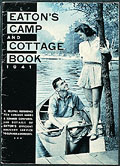 |
|
| |
 Eaton's
Camp and Cottage Book, 1941, cover. Eaton's
Camp and Cottage Book, 1941, cover.
|
|
| |
|
|
|
The last Camp and Cottage Book appeared in 1941. The special cottage
delivery
service continued, however. In 1964, the Superintendent's Office
issued
"Important Notice No. 92: As in past years, special arrangements
have been
made to deliver to summer cottages … from [June 9] to Sept. 30th,
inclusive.
These arrangements … are an extension to our regular Out-of-Town
Delivery
Policy … [they] consist of paying for trucking services, generally
from
railway stations to cottages and summer resorts. In some instances it also
includes
a delivery service by boat, from a steamship dock to a local dock."
The memo goes on to inform staff that the free service should not
include
uncrating, installation or delivery from the dock to the cottage door.
Local deliverymen were not quite so bound by company rules. Peter Wood,
whose
father had the Eaton's contract to deliver by truck around Rosseau,
helped
out until the mid-1960s.
| |
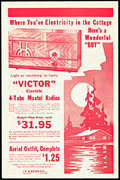 |
|
| |
 For
those lucky cottagers who had electricity, a radio from the Eaton's
catalogue
helped them stay well informed throughout the summer. Eaton's Summer
Home Handbook, 1937, insert. For
those lucky cottagers who had electricity, a radio from the Eaton's
catalogue
helped them stay well informed throughout the summer. Eaton's Summer
Home Handbook, 1937, insert.
|
|
| |
|
|
|
"It took three men and a boy to do a cottage delivery," he
recalls,
"especially if it was something heavy. Pop took one end, my older
brothers
or cousins took the other, and they'd still need a boy to hold the
screen
door open. That was me. Some of those paths from road to cottage were like
goat
paths — quaint and woodsy to walk but a helluva thing to carry a
fridge
down, especially for the one walking backwards." Frank T. Wood and
the
boys did more than deliver to the door. They uncrated the big stuff and
the crates
went home to be play forts. And they hauled away whatever was being
replaced,
to the dump or if, like an old lawn mower, it had salvageable parts, back
to
town for recycling into the local economy.
Eaton's customers were not above taking advantage of the
firm's
old-fashioned dedication to service. One customer ordered something every
day
and inevitably returned it. When queried, she explained that her dog
didn't
get enough exercise and needed somebody to chase every day.
| |
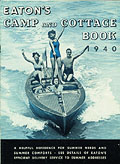 |
|
| |
 Eaton's
Camp and Cottage Book, 1940, cover. Eaton's
Camp and Cottage Book, 1940, cover.
|
|
| |
|
|
|
For Eaton's, delivery was a costly service. And, from the 1950s,
the
company faced fierce competition from Simpson-Sears. The new mail-order
rival
did not include the cost of delivery in its published prices, which made
their
goods look cheaper than Eaton's. Overall, the catalogue division
lost $40
million in a decade and closed finally in 1976 amidst a public outpouring
of
nostalgia for the book that was a country's wish list for nearly a
century.
It isn't just one company, but a way of doing business that has
faded
away. Like Eaton's, the ice man and the vegetable boat no longer
call at
cottage docks.
| |
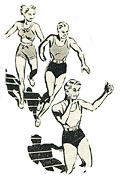 |
|
| |
 The
Eaton's catalogue helped Canadian cottagers enjoy their summer at the
lake. Eaton's Summer Home Handbook, 1937, p. 3. The
Eaton's catalogue helped Canadian cottagers enjoy their summer at the
lake. Eaton's Summer Home Handbook, 1937, p. 3.
|
|
| |
|
|
|
| |
 |
|
| |
 Spork
was a convenient alternative to fresh meat. Eaton's Camp and Cottage
Book, 1941, p. 4-5. Spork
was a convenient alternative to fresh meat. Eaton's Camp and Cottage
Book, 1941, p. 4-5.
|
|
| |
|
|
|
The cottage editions occupied but one brief niche in Eaton's
history,
but the time and the place they portray remain the central memory for a
generation
of cottagers. And the forces that led to the rise and fall of
Eaton's cottage
service remain relevant today. Cottage shoppers still fret over the choice
between
the city's big-box prices and small-town service, and all retailers
face
new competition from that other big E on the net. What's lost
forever is
that $1.75 chair, delivered to the end of the dock, along with a 3¢
novel.
Just hold the Klim.
|